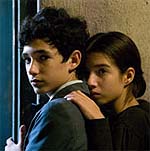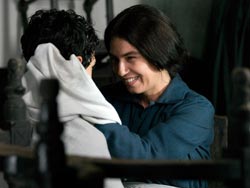Fernando Perez’s New Take on Jose Marti
Irina Echarry

HAVANA TIMES, April 5 — The latest movie by Cuban director Fernando Perez premiered this first days of April at the Charlie Chaplin Theater in Havana. As was expected, the public attended the function of “Jose Marti, the Eye of the Canary” searching for their national hero. But, what did they find?
We Cubans are used to the mystification of our native heroes —wrapping them up in the mantel of absolute goodness and putting them in an urn so they do not become contaminated with daily routine (as if they had not emerged from it).
Therefore, the construction of Jose Julian (the lead character in the film) and the pre-established image of Marti (the one they teach us in school and in writings about him) had a good bit of distance between them.
That was what the director and script writer wanted to show us: the human being that Marti could have been.
To facilitate the task Perez chose the period of Marti’s childhood and adolescence, stages that take him away from being the revolutionary thinker and poet about whom so much is spoken.

Since there is little documentation concerning these years of the Marti’s life, the film director had the opportunity to give free rein to his imagination.
In this way we’re shown him as being an excessively withdrawn, nervous boy who is emotionally struck by everything he sees: the abuse of animals and people, the beauty of the Cuban landscape, other people’s pain, the mother’s tender love, the vision (less infantile) of a breast that arouses adolescent lust, and his father’s obstinate authoritarianism (at times we are led to believe that Mariano is a symbol of the Spanish colonizer and slave owner from which the son will have to somehow free himself).
He is a boy who is mistreated by other school children, who learns how to masturbate and to commit fraud. The viewer captured by the scenes that unfold might forget that he is our national hero. This is a fitting film for children to familiarize themselves with Marti the human being.
Everything (except for a few exceptions) is marked by good performances, photography that isn’t forgotten easily and an atmosphere that attempts to take us back to that time.

What catches one’s attention is that the adults are not able to sense this boy’s transition as he learns about the world and reflects on the universe, existence and about his homeland and freedom.
The transition from childhood to adolescence is abrupt, and the character’s spiritual growth is only insinuated in a few scenes and in several close-ups of Jose Julian Marti’s face; emphasis is placed on the social atmosphere more than on the inner world that is being forged in Marti.
It is a conventional film, with neither esthetic nor avant-garde innovations, with a beautiful soundtrack by Edesio Alejandro and fitting photography by Raul Perez Uretra (the 2010 winner of the Cuban Cinema Award).
The discussion in the classroom on the type of freedom and democracy that Cuba needs, especially in the way the students speak, contemporizes the air of the film which the crew wanted to breathe into the story so as to make it more appealing to today’s youth who go to see it.
This is a good opportunity to come closer to the Marti of Fernando’s Perez and to imagine our own, the one that each one of us would like.






Later this year a DVD might be available in Cuba. The film might also get accepted in different international film festivals.
Will it be possible to see this outside of Cuba?